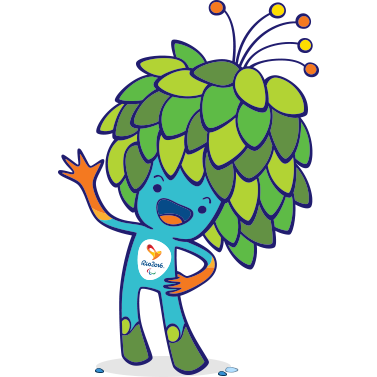The 2016 Paralympics Has Its Very Own Plant Mascot
Though the 2016 Olympics has come with its fair share of challenges for Rio de Janeiro, Tom, the Paralympic mascot, hasn’t stopped smiling. Tom is a fusion of Brazil’s diverse plant life and he goes hand-in-hand with the Olympic mascot Vinicius, a catlike creature who represents Brazil’s animal life. Tom was born in 2009, his hair is made of foliage, and he sleeps in the Tijuca forest. Vinicius is his best friend.

“The Rio 2016 mascots represent the diversity of our culture, of our people,” Beth Lula, the Rio 2016 brand director said. “They represent our joy, our way of being. Both of them are magical creatures with super powers and relate naturally with the young audience, who we want to engage with our event so much.”
Tom, who looks like he’s wearing a tree on his head, is “energized by photosynthesis and can pull any object from his head of leaves. He is always growing and overcoming obstacles.”
Tom’s design is influenced by pop culture, video game, and animation characters. The mascots, a playful aspect of the Olympics, are a key part of the Olympics’ marketing campaign, which plans to reproduce them on over 12,000 products each games. “Our expectation is that the mascots will represent 25 percent of our (merchandising) business,” Slymara Mutini, head of licensing, said in 2014, shortly after the mascots were announced.
According to the Olympics website, Tom, who looks like he’s wearing a tree on his head, is “energized by photosynthesis and can pull any object from his head of leaves. He is always growing and overcoming obstacles.”
The independent animation studio Birdo Produções, who spent over a year working on these mascots, ultimately won the country-wide competition. “His power represents the reinvention of the Paralympic athletes,” they wrote of Tom.
When the Paralympic mascots were originally released in 2013, they didn’t have names; the decision was left to the public’s vote. “Three choices were on offer: Oba and Eba; Tiba Tuque and Esquindim; and Vinicius and Tom. A total of 323,327 votes were registered.” Tom and Vinicius won with 44 percent of the votes, according to the Olympics’ website.
As much as these mascots are playful inventions, their presence, both online and offline, is certainly real. Tom and Vinicius both have active Instagram and Facebook accounts filled with colorful photos and bright, elaborate illustrations. Tom is playing drums in one image, at the beach in another, and posing with his fans in many others. Here’s a quote from Tom himself: “I use my head. I really do! To get myself out of any jam, I pull the craziest objects out of my head of leaves. After all, I know all the secrets of nature and I understand that with creativity, intelligence and determination, we can achieve whatever we want.”
The mascots have also been turned into an animated series called “Vinicius and Tom: Funny by Nature”. Episodes are available online on Cartoon Network Brazil’s website and on Rio 2016’s Youtube channel. The 2-minute long episodes use music but no language, making them accessible to an international audience. (They tell funny and simple stories about the two of them and their experiences in Brazil’s forests. According to the Rio2016 website: “This is the first time in the Americas and only the third time in history that the Games’ mascots have been immortalized in TV cartoon form.”)
Vinicius and Tom are also featured on different products, including cups, bags, stamps and toys, and in coloring books, as well as paper toys, computer wallpaper, and masks, which can be downloaded on the Rio Olympics official website. Vinicius and Tom are a fun, not to mention profitable, way to bring excitement to the Olympics for children, and to celebrate pride for Brazil’s natural life– a symbol of the enduring power of nature that the entire world can get behind.




































